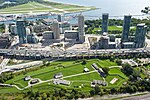Factory Theatre is a theatre in Toronto, Ontario, Canada. It was founded as Factory Theatre Lab in 1970 by Ken Gass and Frank Trotz, and it was run for almost 20 years by Dian English.
Factory was the first theatre to announce that it would exclusively produce Canadian plays, but it soon became a widely emulated policy by other theatre companies. Factory became known as the home of the Canadian playwright, and is often associated with George F. Walker, most of whose plays premiered there.
For over four decades, Factory Theatre has developed and produced some of the finest theatrical works in Canada's national canon and been home to some playwrights of the country.
In any given year, more than 50,000 patrons come to Factory’s historic Victorian mansion at the corner of Bathurst and Adelaide Streets (in the heart of Toronto’s cultural west-end district) – an inviting, inclusive environment where ideas and imagination intersect.
Factory Theatre is unique in that it is committed solely to the development and production of Canadian plays through staged readings, workshops, Natural Resources (resident creation groups), writers’ retreats, residencies, Factory Wired (festivals of new work in progress), and ultimately premiere productions.
The Factory Theatre play development program is committed to the long-term investment of playwrights and creators and Canadian work that celebrates our diversity by engaging, provoking, entertaining, and inspiring our artists, audience and the community at large.
Factory has been known as the home of the Canadian playwright as well as supporting a broad spectrum of forms and voices, and is also dedicated to serving its community by building a strong neighbourhood identity in its role as a cultural hub. Partnerships with local schools and businesses and initiatives, such as its Neighbours Nights and Curtain Raiser events, are what ground it as a remarkable artistic resource and cultural institution.









